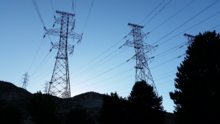Electric Power Transmission System
– Electric power transmission is the bulk movement of electrical energy from a generating site to an electrical substation.
– Transmission lines form a network that is distinct from local wiring for distribution.
– Efficient transmission requires high voltages to reduce losses.
– Transmission lines use either AC or DC, with voltage levels changed by transformers.
– Interconnections connect generators and consumers in a wide area synchronous grid.
Overhead Power Transmission
– Overhead power lines are not covered by insulation.
– Aluminum alloy is commonly used for overhead conductors.
– Conductor sizes range from 12mm to 750mm, with bundle conductors used for higher capacity.
– Transmission-level voltages are usually 110kV and above.
– Adverse weather conditions can interrupt transmission.
Underground Power Transmission
– Underground power cables can be used for transmission.
– Underground cables have lower visibility and are less affected by weather.
– Insulation is required for underground cables.
– Cable and excavation costs are higher than overhead construction.
– Faults in buried transmission lines take longer to locate and repair.
Control System for Electric Power Transmission
– A sophisticated control system is required to match power generation with demand.
– Imbalance between supply and demand can cause automatic disconnection or shutdown of generation and transmission equipment.
– Regional blackouts can occur if the imbalance is not managed.
– Interconnected transmission networks reduce the risk of failures by providing alternative routes for power flow.
– Transmission companies determine maximum reliable capacity to ensure spare capacity is available.
HVDC Technology in Electric Power Transmission
– High-voltage direct current (HVDC) technology is used for greater efficiency over longer distances.
– HVDC is used in submarine power cables and for power interchange between unsynchronized grids.
– HVDC links stabilize power distribution networks and prevent synchronization problems.
– HVDC technology reduces the risk of cascading failures.
– HVDC requires different designs for voltages above 765kV.
Subtopic: History of Electric Power Transmission
– Commercial electric power initially transmitted at the same voltage as lighting and mechanical loads.
– Different classes of loads required different voltages and generators.
– Generators were sited near their loads, known as distributed generation.
– Transmission of alternating current (AC) became possible with Gaulard-Gibbs transformer.
– First long-distance AC line built in Turin, Italy in 1884.
– William Stanley, Jr. developed the first practical series AC transformer in 1885.
– Westinghouse installed AC systems in 1886 after Stanley’s demonstration.
– Induction motors running on polyphase current invented by Ferraris and Tesla.
– Widespread use of polyphase motors delayed by development problems.
– Smaller electric companies merged into larger corporations like General Electric and Westinghouse Electric.
– AC systems allowed for economies of scale with large generating plants.
– Interconnection of loads became possible through rotary converters and motor-generators.
– First transmission of single-phase AC using high voltage in Oregon in 1890.
– First three-phase AC transmission took place in Frankfurt in 1891.
– Transmission voltages increased throughout the 20th century.
Subtopic: Bulk Transmission
– Transmission substation decreases voltage for local distribution.
– Power lines, cables, circuit breakers, switches, and transformers used in transmission networks.
– Higher voltage and lower current improve transmission efficiency.
– Optimum conductor size determined by Kelvin’s law for conductor size.
– Transmission networks administered by regional entities.
Subtopic: Importance of Transmission Infrastructure
– Interconnection of generation plants and distribution networks became critical infrastructure.
– World War I spurred the building of large generating plants for munitions factories.
– Transmission efficiency improved through higher voltage and lower current.
– Thicker wires are optimal during times of lower interest rates and low commodity costs.
– Kelvin’s law used in conjunction with long-term estimates of copper and aluminum prices and interest rates. Source: https://en.wikipedia.org/wiki/Electric_power_transmission
This article has multiple issues. Please help improve it or discuss these issues on the talk page. (Learn how and when to remove these template messages)
|
Electric power transmission is the bulk movement of electrical energy from a generating site, such as a power plant, to an electrical substation. The interconnected lines that facilitate this movement form a transmission network. This is distinct from the local wiring between high-voltage substations and customers, which is typically referred to as electric power distribution. The combined transmission and distribution network is part of electricity delivery, known as the electrical grid.

Efficient long-distance transmission of electric power requires high voltages. This reduces the losses produced by strong currents. Transmission lines use either alternating current (AC) or direct current (DC). The voltage level is changed with transformers. The voltage is stepped up for transmission, then reduced for local distribution.
A wide area synchronous grid, known as an "interconnection" in North America, directly connects generators delivering AC power with the same relative frequency to many consumers. North America has four major interconnections: Western, Eastern, Quebec and Texas. One grid connects most of continental Europe.
Historically, transmission and distribution lines were often owned by the same company, but starting in the 1990s, many countries liberalized the regulation of the electricity market in ways that led to separate companies handling transmission and distribution.
